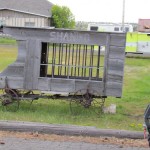There are plenty of Colorado Ghost Towns. In fact there are over 1,500 to be precise, but only about 640 of these remain. These ghost towns came about for a number of reasons: mines closed, coal supplies depleted, silver lost its value, farm towns deserted due to rural depopulation, stage stops abandoned with the birth of the railroad system, or resort towns that never amounted to anything. Some of these towns have been completely abandoned, others have been rebuilt and a few residents still remain. Take a trip to one or all ten of these blasts from the past if you dare.

St. Elmo | Chaffee County
St. Elmo is one of the most visited and best preserved ghost towns in Colorado. Today, multiple business structures and cabins remain.
St. Elmo became an official town in 1880 when gold and silver began attracting people to the area. It was known for its single male population and was filled with saloons, dance halls, and a bawdyhouse. When the Alpine Tunnel was under construction, the town was well known for Saturday night misbehavior. The town had a good 30-year stretch until it reached its decline in 1910. With the failure of the mines in the area and the closure of the Alpine Tunnel, St. Elmo’s population began to whittle.
St. Elmo has many buildings considered to be private property. The nearby mountains have miles of underground tunnels that are dangerous. Obey posted signs, do not trespass, and exercise caution when exploring the area.

Dearfield | Arapahoe County
Dearfield may now only consist of a few crumbling buildings and a historical marker, but this once was a community of a few hundred people.
Dearfield was established in 1910 as an agricultural colony. The first settlers came to town in 1911, and by 1920 close to 200 residents called Dearfield home. The town had two churches, a school, a restaurant, and there was once talk of building a canning factory and college. But the town soon met its demise shortly after. By 1946, after the Colorado Dust Bowl, only one resident remained in the small town. Now the town is the property of the Black American West Museum.
The buildings that remain may be on the verge of demolition, but there are quite a few other staples that remain such as wash machines and chairs. Visitors are encouraged not to enter the buildings due to structural instability, hantavirus, and snakes.

Sunset | Boulder County
Imagine hearing, “Sunset is just up ahead” while you are on a train. This is what many passengers heard as they rode the railroad in the early 20 th century. Sunset was more than just an important train stop for the Denver, Boulder, and Western regions. There were also a number of mines in the area. However, Sunset wasn’t as booming as other Colorado ghost towns. At it’s peak it was only home to 175 residents.
Sunset started first as a lumber camp, then became a mining town. Sunset at one point was even a summer resort town until a fire burned the hotels in town. Sunset officially sank into the horizon in November 1921.
Today, not much remains in Sunset aside from several buildings and an ore cart. Aside from exploring the remainders of Sunset, it is also great access point for the Switzerland trailhead, a 14-mile trail.

Crystal | Gunnison County
Crystal still has houses, an old saloon, and a store. From July 4 th through Labor Day weekend, there is also the Crystal Gift Shop which sells collectibles, candy, and refreshments. It is also still home to seasonal tourists from June through October, but come winter time it becomes a true ghost town.
The town of Crystal was incorporated in 1881 by silver, copper, lead, zinc, iron, and gold miners. At its peak, there were about 400 residents in Crystal. It hosted a barber shop, two hotels, a pool hall, and a men’s club. By 1915, only eight people remained in Crystal.
Today the Crystal Mill is one of the most photographed historic sites in Colorado, listed on the National Register of historic places in 1985. The mill harnessed the river adjacent to the mill to power the air compressor inside. The mill closed operations in 1917 but there have been several efforts to preserve it.

Ironton | Ouray County
Ironton was founded in 1883 at 9,800 feet elevation at the north end of the Red Mountain Mining District. It was one of the wealthiest Colorado ghost towns, and was an important staging stop and supply center. At its peak, the town housed between 800 and 1,000 residents. Unfortunately for Ironton, the water in this area contained sulphuric acid and ate away the metal machinery used in the mines. Because of this, the mines in the area closed and the population in Ironton declined.
Ironton was still in existence up until the late 1960’s. An episode of “I’ve Got a Secret, airing on December 18, 1961 was even filmed here with the last resident of the town, Milton Larson. Milton and his brother stayed in the town working the mines until they passed away.
Today, several buildings remain behind. Through a grant, the Red Mountain Project is currently stabilizing two of the three homes left standing in the town.

Animas Forks | San Juan County
Up high in the San Juan Mountains sits the ghost town of Animas Forks, at an impressive 11,200 feet. Here, several old buildings remain.
Animas Forks first came to be in 1873, when the first cabins were built. Three rivers meet nearby, one of them being the Animas River which is where the name of the town came about. By 1876, Animas Forks was a growing mining community. The town had 30 cabins, a hotel, a saloon, a post office, and a general store. About 450 people called Animas Forks home in 1883. In 1884, a blizzard covered the town in 25 feet of snow but this didn’t cause the demise of this ghost town. Instead, the town closed once mining stopped in the area.
To get to Animas forks with at two-wheel drive vehicle you will need to visit in summer. Otherwise, a four-wheel drive vehicle is required. Once you arrive, the BLM and San Juan County have interpretive brochures and maps of the ghost town for your reading pleasure. A few buildings are still in tact but fragile.

Eureka | San Juan County
Eureka was located in between fellow ghost towns Animas Forks and Silverton. Gold was first discovered near Eureka in 1960 in the San Juan Mountains. However, the Ute Tribe forced miners out in 1861 who had been awarded the land in a US treaty. The prospectors returned ten years later, when lode gold was discovered in the Little Giant vein at Arrastre Gulch. The miners were allowed to stake their claim after the Brunot Treaty of 13 Sept. 1873. By 1875, Eureka had a post office and was near the Silverton Northern Railroad stop. When the Sunnyside Mill closed in 1939, the population quickly declined.
Today, there isn’t much that has been left behind in Eureka. The only structure that remains in Eureka is the Eureka jail, which has been restored. The foundation of Sunnyside Mill also remains.

Silverton | San Juan County
Although it once was part of Barker City, Silverton officially came to be in 1874. The town sprung into existence thanks to the rich silver properties found in the area. Because of this lucrative find, the population soared in Silverton to close to 4,000 people by the end of 1874 (although another source claims it was closer to 3,000). As the population increased so too did the need for more establishments which included a lodge, three sawmills, stables, saloons, stables, schools, and restaurants. When the railroad arrived in Silverton in July of 1882, the population expanded even further. Silverton met its demise with the silver crash of 1893.
Silverton is still accessible to this day by following U.S. Highway 550 south from Montrose. It is one of Colorado’s most preserved ghost towns and tours are offered regularly.
Brown, L. Robert. (1968, January 1) Ghost Towns of Colorado Rockies.

Saints John | Summit County
Saints John, once known as Coleyville, is a former silver mining town and was one of the first towns to discover silver in Colorado. Although it is considered a ghost town, a few people still reside in Saints John.
A prospector named Coley first discovered silver in Saints John in 1863 on the slope of Glacier Mountain. Other prospectors followed suit, including John Cullom, who discovered the Saints John Lode. In 1867 Cullom sold the Saints John Lode to the Boston Silver Mining Company, which built an ore mill. The ore mill helped grow the town’s population. In the 1870 census, the town officially changed its name to Saints John and had a population of 71. Saints John had a post office, store, saw mill, assay office, and smelting furnace. When the mine stopped working in 1928, so too did the people of Saints John.
Today, Saint Johns is accessible by a dirt road from Montezuma. Winters here were and still remain brutal. In 1898, 10 snowslides occurred in one morning and snow packed all the wayup to second-story windows of boarding houses. In the winter, the hike up from Montezuma on snowshoes is rewarding for avid hikers. The town resides at the far end of a long meadow. Foundations of the home of Captain Samspon Ware remain as well as a few buildings.

Orient | Chaffee County
Orient was a booming mining town back in its day. It became one of the country’s largest working iron ore mines after the town was discovered in 1870. In 1881 the railroad came through the town and the town began to boom until the surface veins of ore depleted in the early 1920s. CF&I decided to give Orient a second chance and built a new company town below the mine, known as New Orient. New Orient prospered until 1932 when the mines closed and the residents of the town abandoned it. After the town was abandoned, a massive cave-in created the Glory Hole.
At its peak, Orient was home to 400 residents. Today it is home to 250,000 Brazilian free-tailed bats during the summer.
Today all that remains of Orient is the Glory Hole and foundations from the New Town of Orient. It can be accessed via a 2-mile hike to the mine from Valley View Hot Springs. The hike begins at the resort where you can get a detailed map of the area.

Photo Credit: Melinda Duncan , Wikipedia , Don O’Brien , Wikipedia , Courtney Gibbons , Wikipedia , Chuckcars , Wikipedia , Ed Ogle , Wikipedia , John Fowler
 10 Arizona Ghost Towns to Check Off Your Bucket List
10 Arizona Ghost Towns to Check Off Your Bucket List

